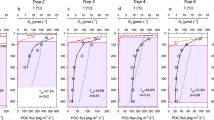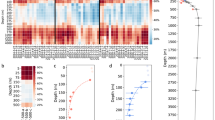Abstract
QUANTIFICATION of the flux of organic carbon from the ocean surface to the deep ocean and sea floor is crucial to the prediction of future levels of atmospheric carbon dioxide and the interpretation of organic carbon variations in marine sediments. We report here the results of a study of benthic exchange and metabolism based on in situ benthic flux-chamber, in situ oxygen microelectrode and shipboard pore-water measurements performed off the central California continental shelf. At the base of the continental slope, the rates of benthic carbon mineralization exceed 0.8 mol C m−2 yr−1. Seaward of the slope and rise, however, rates decrease to <0.05 mol C m−2yr−1 in the North Pacific central gyre. These results indicate that, across the northeast Pacific, about half of the input of organic carbon to the sea floor occurs within 500 km of the continental slope. Measured rates of benthic carbon oxidation near the continental margin exceed the fluxes of organic carbon determined from previous sediment-trap studies by a factor of about three. In this region, therefore, either traps significantly underestimate the mean flux of vertically sinking particulate organic carbon (perhaps by under-sampling important episodic events) or more than half of the organic-carbon input is due to processes that by-pass traps, such as near-bottom lateral or active biological transport.
This is a preview of subscription content, access via your institution
Access options
Subscribe to this journal
Receive 51 print issues and online access
$199.00 per year
only $3.90 per issue
Buy this article
- Purchase on Springer Link
- Instant access to full article PDF
Prices may be subject to local taxes which are calculated during checkout
Similar content being viewed by others
References
Berger, W. H., Fischer, K., Lai, C. & Wu, G. Undersea Res. Symp., 88-1 (ed. Agegian, C.) 131–176 (National Oceanic and Atmospheric Administration, Silver Springs, 1988).
Eppley, R. W. & Peterson, B. J. Nature 282, 677–680 (1979).
Harrison, W. G., Platt, T. & Lewis, M. R. J. Plank. Res. 9, 235–248 (1987).
Yoder, J. A. & Ishimaru, T. Cont. Shelf. Res. 9, 547–553 (1989).
Jahnke, R. A. & Jackson, G. A. Nature 329, 621–623 (1987).
Martin, J. H., Knauer, G. A., Karl, D. M. & Broenkow, W. W. Deep Sea Res. 34, 267–285 (1987).
Jahnke, R. A. & Christiansen, M. B. Deep Sea Res. 36, 625–637 (1989).
Strickland, J. D. H. & Parsons, T. R. Bull. 167 (Fish Res. Board Can., Ottawa, 1972).
Reimers, C. E. Deep Sea Res. 34, 2019–2035 (1987).
Jahnke, R. A. Limnol. Oceanogr. 33, 483–487 (1988).
Tabatabi, M. A. Envir. Lett. 7, 237–243 (1974).
Thompson, J. B., Mullins, H. T., Newton, C. R. & Vercoutere, T. L. Lethaia 18, 167–179 (1985).
Vercoutere, T. L., Mullins, H. T., McDougall, K. & Thompson, J.B. J. sedim. Petrol. 57, 709–722 (1987).
Anderson, R., Fleisher, M. & Santschi, P. H. (abstr.) Trans. Am. geophys. Un. 71, 124 (1990).
Reimers, C. E. (abstr.) Trans. Am. geophys. Un. 69, 1123–1124 (1988).
Archer, D., Emerson, S. & Smith, C. R. Nature 340, 623–626 (1989).
Buchholtz-ten Brink, M. R., Gust, G. & Chavis, D. Deep Sea Res. 36, 1083–1101 (1989).
California Cooperative Oceánic Fisheries Investigations Data Rep. SIO Ref. 84-18. 84-23, 84-25, 84-30 and 85-1 (Scripps Institution of Oceanography, La Jolla).
Smith, K. L. Jr Limnol. Oceanogr. 32, 201–220 (1987).
Cole, J. J., Honjo, S. & Erez, J. Nature 327, 703–704 (1987).
Smith, K. L. Jr, Alexandrou, D. & Edelman, J. L. Deep Sea Res. 36, 1427–1441 (1989).
Houston, K. A. & Haedrich, R. L. Mar. Biol. 92, 563–574 (1986).
Honjo, S., Spencer, D. W. & Farrington, J. W. Science 216, 516–518 (1982).
Richardson, M. J. Deep Sea Res. 34, 1304–1329 (1987).
Thorpe, S. A. & White, M. Deep Sea Res. 35, 1665–1671 (1988).
Richardson, M. J. & Hollister, C. D. J. mar. Res. 45, 175–200 (1987).
Grant, J., Volckaert, F. & Roberts-Regan, D. L. Cont. Shelf Res. 7, 1123–1138 (1987).
Murray, J. W. & Kuivila, K. M. Deep Sea Res. 37, 59–80 (1990).
Author information
Authors and Affiliations
Rights and permissions
About this article
Cite this article
Jahnke, R., Reimers, C. & Craven, D. Intensification of recycling of organic matter at the sea floor near ocean margins. Nature 348, 50–54 (1990). https://doi.org/10.1038/348050a0
Received:
Accepted:
Issue Date:
DOI: https://doi.org/10.1038/348050a0
This article is cited by
-
Transitions in microbial communities along two sediment cores collected from the landward walls of the New Britain trench
Marine Biology (2020)
-
Abundance and richness of key Antarctic seafloor fauna correlates with modelled food availability
Nature Ecology & Evolution (2017)
-
Benthic Carbon Mineralization and Nutrient Turnover in a Scottish Sea Loch: An Integrative In Situ Study
Aquatic Geochemistry (2016)
-
A Tribute to Rick and Debbie Jahnke: From Deep Sea Pore Water to Coastal Permeable Sediments-Contributions that Cover the Oceans
Aquatic Geochemistry (2016)
-
Seasonal export fluxes of size-fractionated particulate derived from polonium-210: A case study in Xiamen Bay
Chinese Journal of Oceanology and Limnology (2010)
Comments
By submitting a comment you agree to abide by our Terms and Community Guidelines. If you find something abusive or that does not comply with our terms or guidelines please flag it as inappropriate.



